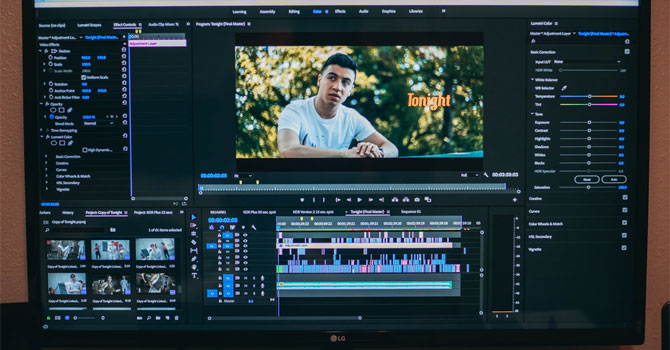As a result of the high demand for video in content marketing, the advancements in technology that make remote work a cinch, and the popularity of the digital nomad lifestyle, this is the perfect time to consider being a freelance video editor.
- Inbox Dollars - Get paid to check your email. $5 bonus just for signing up!
- Survey Junkie - The #1 survey site that doesn't suck. Short surveys, high payouts, simply the best.
- Nielsen - Download their app and get paid $50!
Working from home, or from anywhere, really, is attractive to a lot of people who can’t or choose not to live the 9-to-5 life in an office because of various reasons, such as lack of childcare, a disability or illness, or simply the lack of flexibility in an office job.
In today’s article, learn all about what a freelance video editor does, how to become one, and the best places to find freelance video editor jobs.
What Is a Freelance Video Editor?
So, what is a freelance video editor?
A video editor is someone who applies production and post-production changes to a film or digital video, with the aim of telling a story in the most compelling way.
When a video editor is working freelance, this means that they’re not tied to a single production company and can accept projects from anyone or any company.
A video editor works closely with the director to maintain integrity, edit scenes, select angles and points of view (POVs), and implement post-production enhancements.
The video editor works closely with the director to make changes that help keep the viewer’s attention and provide them with the information needed to understand the film while retaining the director’s vision.
Video editing usually involves cutting and rearranging scenes so that the final length of the film is reasonable in context with the subject and the viewers’ attention span.
If applicable, the video editor also makes decisions about which angles and POVs are used in certain scenes, keeping in mind the viewer experience and whether it adds or detracts from the story the film is trying to tell.
The post-production phase involves incorporating CGI or other enhancements, such as lighting, sound, and other special effects, into the film to achieve a certain appearance, again, in the service of the story.
Video Editing Workflow
Think of video editing as a process that starts with raw footage, alternates between addition and reduction, and results in the final product that is a work of art. Here’s how a typical workflow goes when you’re working on a project.
1. Organize the clips.
The start of a project is usually marked by a file dump of raw footage.
It may be overwhelming at first, but you’ll make your work easier down the line by organizing the files first.
Label each file and sort them into folders so you’ll know where to get them and they’re easier to retrieve.
2. Create a rough cut.
Making a rough cut involves laying out the basic structure and sequence of scenes in the video.
This is the most tedious step but the most important, as this is where the story takes shape.
The rough cut starts with the script; use this as a guide to establishing the story that will be told. From the script, you can begin selecting clips and placing them in order according to the timeline indicated in the script.
When you’ve done the first pass of assembling the clips, watch the whole thing through and make sure that it makes sense, there are no holes in the narrative, and there are no shots that are out of place.
Have the director watch the rough cut and give feedback on it. You might go through a few rounds of revision and feedback before your rough cut gets approved.
No joke. Here are the fastest ways to make easy money online. Click here to see how.
3. Produce the fine cut.
When your rough cut is complete and approved, you can start with your fine cut.
This involves placing and timing each shot and each cut so that it’s at a pace that presents the story and delivers the right emotions at the same time.
The resulting fine cut should have every shot in its proper place, set in the right timeline.
Again, have the director watch it and give feedback, no matter how many rounds it takes. You’ll need their total, 100% approval to move on to the next phase.
4. Go into picture lock mode.
Once the fine cut is approved, the edit is in picture lock, meaning the sequence, timing, and the footage are set.
Picture lock is the time to clean up any stray clips from the scene and organize audio cues and sound effects to make the sound mixing seamless.
5. Finalize the video.
Clean up the audio tracks; make sure dialogue, sound effects, and score are mixed seamlessly with the corresponding video.
Color correction and color grading are done in this stage, as well as visual effects and CGI, when applicable.
You’ll probably go through another few cycles of revision and feedback here before the final product is rendered.
When you’ve got final approval, deliver the video to the client in their desired format.
How much should you charge for video editing?
Given your responsibilities and the typical workflow, how much should you be charging your clients?
The average hourly rate of video editors is around $17 to $20 (Source: Salary.com), but you can charge lower or higher depending on many factors.
Factors that affect your wage include the amount of footage you have to sort through, the expected length of the final product, the complexity of the project, the scope of work, and your skills and experience.
One way to decide what you should charge is to look at job seekers’ profiles that are similar to yours (e.g., the same level of education, experience, technical knowledge, etc.) and find out how much they charge per hour.
If you’re only starting with video editing, your pay might not be perfectly in line with the rate you’re looking for.
You can make money from home and it doesn't have to be challenging. Click here to see how.
When you take on more projects, you’ll eventually learn how long certain steps of the editing process take, which will help you more effectively set the price of a project such that you’re paid your target hourly wage.
How To Become a Video Editor
Now that you know what a freelance video editor does, here are the steps to pursuing this career path.
1. Take video editing classes.
Most video editors take up a bachelor’s degree in a field related to filmmaking, broadcasting, communications, or multimedia and video production.
A film school is perhaps the best place to get a degree, aside from universities and colleges, and even community colleges that offer film courses.
If attending school isn’t an option for you for whatever reason, you can also study video editing online.
Massive open online courses (MOOCs), like Udemy, Skillshare, LinkedIn Learning, and Coursera offer online courses that you can normally take at your own pace before a certain deadline.
The courses range from the fundamentals of video editing to software-specific courses; that is, detailed instructions on how to edit footage using specific software.
Vimeo Video School is a collection of articles that are good video editing resources covering a variety of topics.
Taking up additional courses in related skills, such as scriptwriting, directing, lighting, and audio will give you an edge over other video editors in terms of knowing what it takes to make a film.
2. Gather your equipment.
Here are just some of the hardware that you’ll need to do video editing.
Computer. A desktop PC that’s good for gamers is recommended for video editing.
If you have a set budget, buying a desktop PC gets you more processing power and built-in storage than buying a laptop at the same price range, and power and storage are everything when you’re working with videos.
Also, desktop PCs that are made for gamers have superior GPUs (graphics processing units) than those that are geared for normal office work.
If you absolutely must have a laptop for portability, prepare to fork out more money for the same specs below.
For your CPU, aim for at least an Intel Core i7 or i9 processor (or its equivalent), 16 GB RAM, an Nvidia or AMD GPU with at least 4GB VRAM, 1 TB SSD, and complete ports: headphone jack, SDXC card slot, Ethernet, USB 3.0, and HDMI connectors.
As much as possible, get CPUs that are expandable for when technology becomes more advanced.
For your display monitor, aim to have at least a 30-inch monitor with a 4K display, sRGB and Adobe RGB support, and IPS panel technology.
As for your peripherals, using a standard computer mouse is ok, but most professional video editors swear by using a tablet/stylus system, especially the Wacom brand ones.
External hard drives. Yes, plural. Aside from the storage you already have for your CPU, you’ll want to be ready to back up video files that you’re working on at any given time.
Choose external SSD drives instead of HDD drives, with at least 1 TB capacity, and a transfer speed of at least 500 MBps.
Headphones. You’ll want to look for high-quality monitoring headphones; that is, it’s specifically for monitoring audio so it doesn’t alter any audio coming through.
Look for one with a frequency response rate of at least 20–20,000Hz range, an impedance of 250 ohms, and comfortable, fitted ear cups (remember, you’ll be wearing these for hours at a time). Having a replaceable cord is also a plus but not really required.
3. Purchase video editing software.
When you’ve assembled your hardware, the next thing to do is to buy and download your main video editing tool: video editing software.
Here’s a list of the most popular video editing software in the industry.
- Apple Final Cut Pro X — industry standard; $299.99 one-time payment
- Adobe Premiere Pro CC — another industry standard; $20.99/month, billed annually
- Avid Media Composer — good for feature films, broadcast TV; starts at $34.99/month or $239.00/year
- Lightworks — commonly used for feature films; Basic is free, $24.99/month for Pro
You might also need post-production software, such as Adobe After Effects or Blender for 3D graphics.
4. Subscribe to cloud storage.
Freelance video editing involves plenty of back and forth between you and your clients involving different types and sizes of files. Thus, a reliable cloud storage service is essential for any video editor.
Here are the most popular cloud storage services for video editors.
5. Download other tools/software that help you work freelance.
You’ll need some tools to help you work from home effectively. Here are some of the essential tools that you’ll need:
- Project management tools: Trello, Basecamp, Asana
- Time tracker apps: Toggl, TimeCamp, RescueTime
- Accounting system: QuickBooks, FreshBooks
- Video conferencing and messaging tools: Zoom, Skype, Google Meet
- Invoicing tools: Invoice2go | Free Invoice Generator, Invoice Quick, Wave Invoicing, PayPal
6. Gather experience.
No matter what courses or training you take, the best way to learn and create excellent films is to actually do it.
Before you start looking for jobs and projects to work on, you should feel comfortable editing your own films and finishing your own projects.
Get some footage or shoot your own, choose a software, roll up your sleeves and get down to it.
7. Obtain certifications.
Professional certification is not typically required to work as a video editor, but it is a good way to attract more clients and charge higher rates.
Normally, video editing software vendors provide their own certifications. For instance, you can be an Adobe Certified Expert in Adobe Final Cut Pro CC if you pass the certification exam and meet experience requirements.
8. Set up your website and social media.
A self-hosted website is a must-have for any freelancer. This is your home base, your primary marketing tool, and where your portfolio should be displayed.
Plus, when potential clients do a web search for you, you want them to be directed to your website primarily.
Having social media profiles that are professionally geared and is all about video editing will make other people in the groups pay more attention to you because they perceive you as a serious video editor, not just a hobbyist or dilettante.
You may even want to create a separate Facebook business page so clients on your network can see samples of your work, reviews by former clients, and see samples of your work.
Take it one step further by getting a business address and listing your services on Google Business so that your new editing business shows up in local search results. Plus, it’ll give your customers a way to leave reviews, which can then help you attract even more local leads.
Freelance Video Editor Websites To Find Jobs
Now that you’re confident in your video editing skills, you’re probably raring to start on a project or two.
Here are some places to find freelance video editing jobs.
Entertainment Industry Communities
There are plenty of online communities of professionals from the entertainment and media industries that have job boards. These are the first websites you should be going to. Here are a few recommendations:
- Mandy
- Creative COW
- ProductionHUB
- Viedit
- EntertainmentCareers.NET
- Stage 32
- Videopixie
- Staff Me Up
- ProductionBeast
- Media Match
- CareersinFilm.com
- Video Collective (UK-based)
Freelance Job Marketplaces
These are the classic job marketplaces where companies and small businesses find freelancers to do certain jobs. All you need to do is look for video editor jobs and sift through the projects being offered.
Other Places to Find Freelance Video Editor Jobs
Online job boards are certainly helpful in finding opportunities, but there are other places to find video editing jobs.
Your network
It might not seem like it, but you probably know more people than you think.
Start writing down names: family, friends, neighbors, colleagues, former and present co-workers, and casual acquaintances. People you know from high school, college, your gym, your book club, or your neighborhood.
Once you’ve drawn up your list, send out some feelers and let them know that you’re looking for a job.
If you do end up getting a referral or an interview, follow up with those who helped you. Thank them for their help (preferably with a gift!) and let them know whether something came out of the referral or interview.
Wedding suppliers
The wedding industry is worth billions of dollars, and they’re always on the lookout for wedding video editors for same-day edit wedding videos as well as traditional long-form wedding videos.
The tricky thing about being a wedding video editor is the immense pressure to produce a wedding video that is not only artistic but will also conform to the personal tastes of the married couple.
Also, the wedding industry is a referral-heavy industry; it pays to have veterans vouch for you. Attend wedding fairs and befriend as many wedding videographers, planners, coordinators, and other suppliers as you possibly can.
Tips To Be a Successful Video Editor
Improve your chances for success by following these tips:
1. Have a strong demo reel online and ready to share.
When looking for jobs, you’ll need to provide proof of your editing skills. Sometimes, a friend or peer will be merely curious and ask to look at your work out of the blue.
Always be ready with a technically polished editing reel demonstrating structure, pacing, and emotion from a compilation of sections of different editing projects you’ve done.
2. Track your time.
Tracking your time gives you an idea of how long you spend on administrative tasks (e.g., replying to emails, issuing invoices), actual editing work, and how long each portion of editing actually takes.
Not only is it useful for invoices, but you get an idea of how long it takes you to edit, which will help you to estimate how much to charge future jobs.
3. Be organized.
As I’ve mentioned, you’re going to face a deluge of files, and if you don’t organize them early on, you’re not going to be able to do your job efficiently.
Save yourself plenty of time by creating a folder system where all files from a project go into a specific folder and inside are subfolders to separate by file type or by timestamp, if applicable.
3. Back up your work periodically.
I wish I can tell you that computers work as expected 100% of the time.
But unexpected things happen. Your computer might crash, and your files might get corrupted or even deleted.
Set up a backup on the cloud so that you can start up your project again at any time.
4. Keep yourself updated on the latest technology.
Video editing technology advances so quickly from year to year that if you don’t continually update yourself, you’ll get left behind.
Keep your competitive edge by taking the time to read up on all the latest editing techniques and tools, as well as marketing and promotion techniques.
The Bottom Line
Becoming a freelance video editor and working from home isn’t for everyone.
But if you have the talent, you’re willing to work hard to have an excellent output for your clients, and you’re determined to continually improve, both as a freelancer and a video editor, you’re well on your way to success.
Hopefully, the post has been helpful to you as an aspiring video editor.
Other resources
Want to know about other jobs you can do from home? Here’s a list of legitimate work from home jobs you can do.
Or maybe you’d like to start a business instead. Get inspired by our list of small business ideas you can launch from home.









